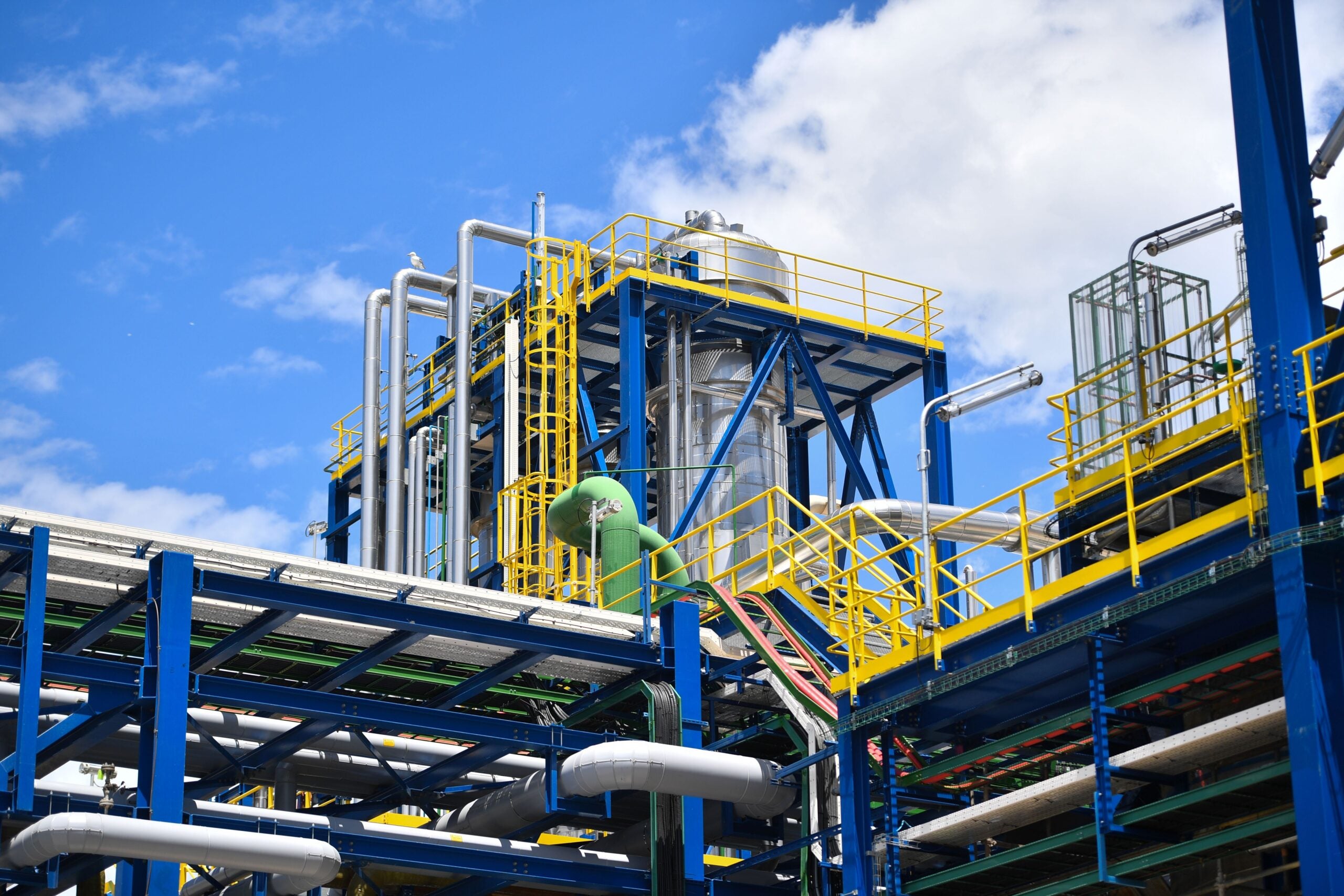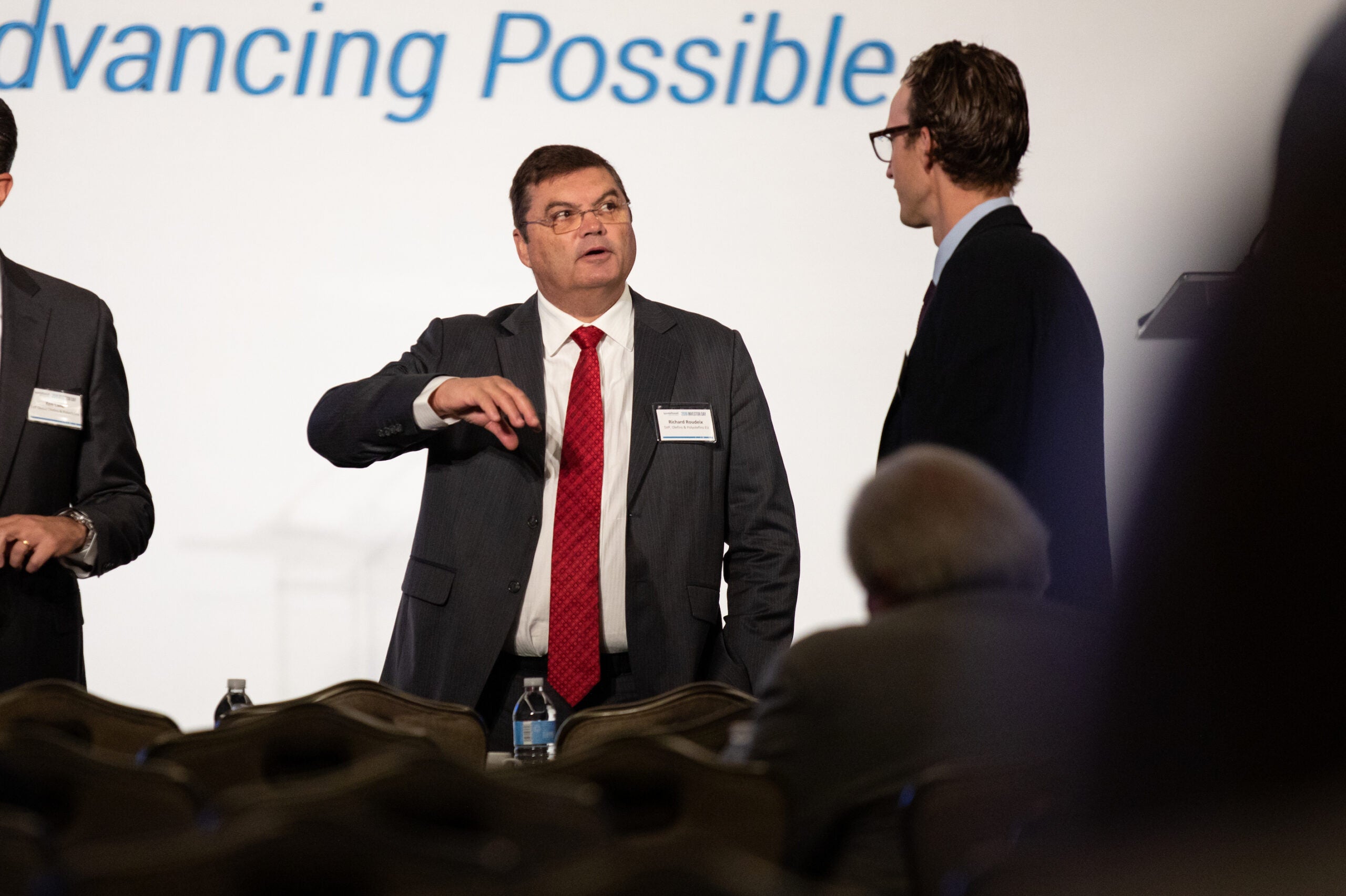
Energy-intensive industries are indispensable to the energy transition, but also difficult to decarbonise. Marco Mensink, director general of the European Chemical Industry Council, and Richard Roudeix, senior vice-president at LyondellBasell, a leading plastics, chemicals and refining company, spoke to Energy Monitor about how to stay in business and be part of the climate solution.
Energy-intensive industries such as steel and chemicals are vital for the energy transition, feeding into everything from wind turbine blades to batteries and insulation, but they are also some of the hardest to decarbonise. How do European chemicals companies intend to go climate neutral?
Marco Mensink: There is a clear case for electrification. One of our members, Covestro, has the biggest power purchase agreement for wind in Europe. We will see more examples where companies choose to power their operations with renewable energy instead of fossil fuels.
We will also take a leadership role in the circular economy. Recycling is part of that, but also integration with other sectors. The US has shale gas. China has a huge labour force. The EU is a small territory and our industries are close together. We can integrate chemicals production with waste management, energy, steel making and refining. That is one thing other regions can’t do as easily. We can recycle the carbon in waste gases from the steel sector into bioethanol, or ‘steelanol’, for example.

In its 2050 vision, Cefic says it expects fossil fuels to remain the most important source of feedstock for chemicals. Does this mean you will focus more on recycling CO2 emissions rather than reducing them through renewable feedstocks?
Some materials will remain carbon based. If you can keep the recycling loop closed and limit its emissions, industrial CO2 can be reused to make climate-neutral chemicals. CO2 may well be the ultimate feedstock for the chemical industry.
We need an accounting framework for carbon capture and use (CCU). To ensure that it makes a genuine contribution to climate action, policymakers need to spell out what counts as an emission reduction and who in the value chain can lay claim to it.
CCU is still niche. Covestro recycles industrial CO2 into a foam that goes into bed mattresses, for example, but the volumes are small. Nevertheless, quite a few companies are looking at reusing carbon, either from industrial waste gases or used plastic.
The business case for chemical recycling, or breaking down used plastic, is getting better, but we still need more information on the environmental, climate and energy profiles of the different technologies out there to decide which ones to take forward.
What is clear is that if you go from a dense carrier like oil or gas to electricity, you need more energy. This will have to be met by a strong agenda on energy efficiency, including breakthrough technologies.
Ultimately, low-carbon solutions will vary by industrial cluster. We are starting a ‘transition monitor’ to answer questions on a much more detailed level. There is no such thing as good or bad technologies. Some will work in one country, others will not. CCS for example is more likely when close to the North Sea, electrolysers need to be near renewables, and in other cases it is about pipelines.
Even if low-carbon technologies vary by region and cluster, they will all require substantial investment. Is the European chemicals industry sufficiently healthy – and incentivised – to invest in the long-term energy transition?
Richard Roudeix: The chemical industry is cyclical. History has shown us to expect ups and downs. We take a decades-long view of our investment decisions.To realise investments, first we need a global level playing field. Products made in Europe must carry the same carbon cost as products made outside Europe. Second, that system must be workable and enforceable. Finally, we need regulatory stability and visibility. In recent years, we have seen EU regulatory changes every five years. This is not compatible with a long-term investment cycle.
Mensink: Low-carbon investments require support for capital and operational expenditure (capex and opex).
The EU Innovation Fund, which is fed by the sale of carbon market allowances and could amount to €10bn from 2020–30, provides cash to demonstrate innovative low-carbon technologies. Energy-intensive industries and CCU are two of its focus areas. The EU’s post-Covid recovery package makes further funds available, creating a unique opportunity to accelerate these projects.
But at the end of the day you still need to create a market for low-carbon products and that is where tools such as contracts for difference (CfD) come in. These would guarantee producers a price for CO2 emissions above the EU carbon market price. Germany intends to pilot them for steel and chemicals production.
Granted, calculating the carbon content in consumer products is even more complex than CCU accounting. But we will need to do it for CfDs and green public procurement. We have to help cleaner industrial technologies move through the same cycle as renewable energies did, from feed-in tariffs to out-competing most fossil fuels.
The European Commission is consulting on a carbon border tax that would put a carbon price on certain imports to counteract the risk of production being transferred from Europe to regions with weaker carbon constraints. Is this a good idea?
Roudeix: A carbon tax is an option. What is most important to us is a level playing field. Whether it is achieved through a carbon tax or a higher share of free allowances in the EU Emission Trading Scheme (ETS), as has been the case so far, is of secondary importance.
Mensink: We have members for and against a tax. But imposing a tax at the border doesn’t help us. We will just be more expensive on the global market.
The difference with steel and cement – the frontrunners on a tax – is that chemicals is first and foremost an exporting sector. European steel and cement companies worry about cheap imports; we worry about expensive exports. This is not just about China. Our trade with China is about €16bn in and out – we export speciality chemicals to China and they export commodity chemicals back to us. But our trade with the UK is €20bn both ways, for example.
There is another question we haven’t answered: which chemical would you tax? The industry is so interlinked there is no one chemical that only punishes the competition.

Has there been carbon leakage or the transfer of chemicals production outside Europe due to EU climate policy?
Roudeix: If you look at base chemicals, most of the investment in recent years was in three regions: the Middle East, China and the US, where growth is expected in the global petrochemicals market. Many different factors go into investment decisions. One of them is global industrial competitiveness and that includes having a level playing field.
Mensink: Building up the ETS, the choice was made to provide free allocation for exposed sectors. That has proven to be the right choice. This has kept us up and running, even with increased climate ambition.
But the EU ETS was never intended to deliver breakthrough technologies. It put the CO2 price on the table of every CEO, while free allowances gave industry the faith and confidence they could work with this system. The EU ETS enabled us to make energy efficiency improvements and switch from coal to gas.
The next step is to get to breakthrough technologies, and for that you need more than a carbon price alone, you need an industrial policy.
There was apprehension within the chemicals industry when the EU adopted its flagship chemicals policy Registration, Evaluation, Authorisation and Restriction of Chemicals (REACH) in 2006, putting European companies under pressure to meet stricter environmental and health standards than their competitors. Yet they adjusted to the change. Could they equally take Europe’s climate neutral ambition in their stride?
Mensink: In the last decade, we have learned to work with REACH. We have invested massive amounts of money to make it work. It has had a very different impact on different companies. For smaller companies especially, the workload is huge.
The similarity with climate policy is that most investments take place in countries that don’t have the same rules and therefore the same costs. REACH has not been followed around the world.
Now Europe is changing the rules again with a new sustainability strategy for chemicals [due in Q4 2020]. Meanwhile, we have to deal with illegal imports; for example, of f-gases. If a carbon border tax were to come, the main question is not how you design it, but how you enforce it.
And who is to say that the most carbon-efficient production is here, and not in China or India? The owner of a renewables-run petrochemical plant in India could send those products to Europe and products from its other plants to the rest of the world. And if that company faced a carbon cost on its European exports, it could spread that out over its entire production and still be cheaper on the European market.
So why would a chemicals company invest in Europe?
Roudeix: There is a significant market in Europe, and we need to serve it, but it is important to emphasise that there is not necessarily a correlation between selling in Europe and producing in Europe.
Supply chains are global. It is the European industry’s global competitiveness that will drive its capability to attract investment – and take part in the energy transition.
Mensink: It is not only about the next plant, but the next technology too. How will we get the newest technologies in a non-growing market? I am not so optimistic. It might be more logical to have such technologies in China or India first, also from a climate perspective.
We already see the Chinese pulling ahead of us sometimes. And Tata Steel finally decided to build its large-scale HIsarna pilot plant – showcasing a breakthrough low-carbon alternative to the blast furnace – in India rather than the Netherlands, despite the prior development work taking place in the Netherlands.
In sum, the European industry’s edge lies in the dialogue it has with policymakers and the support it can get for innovation and economic recovery.
Will the EU’s post-Covid recovery package speed up the energy transition in the chemical industry?
Mensink: We had a Green Deal and now we have a Green Deal with hands, feet, legs and €750bn. If governments put that into hydrogen, grids and – in the long run – renewables production, it will facilitate our transition.
Roudeix: The crisis has triggered a renewed appreciation for plastics and the petrochemicals industry at large – but our long-term vision and strategic priorities have not changed. Europe now has to prove it has the capability to spend so much money in such a short time on projects that add real value for industry and the climate.


